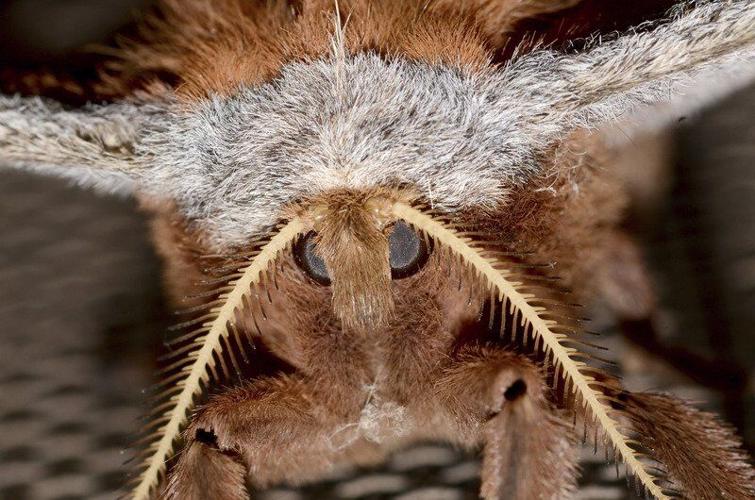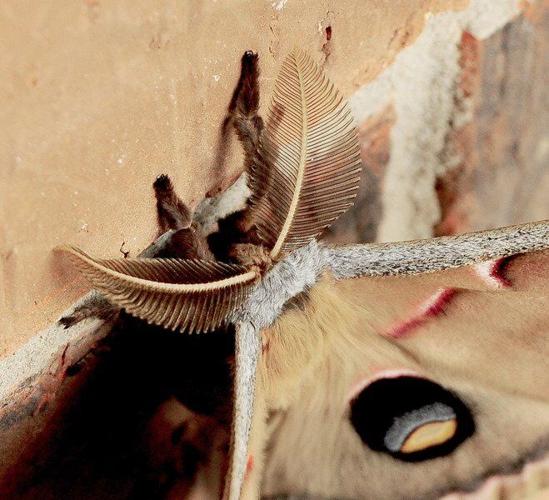Have you ever seen a polyphemus moth? If so, you’ve probably never forgotten the experience.
Their massive size alone would be enough to remember, but they also appear as if they were painted by a talented artist.
I am awestruck every time I see one.
They’re so massive, whenever I look closely at them, they kind of remind me of the original Mothra, the monster moth from the old Godzilla movies. In fact, the polyphemus moth was named after a mythical monster.
Entomologists at the University of Florida report that the moth was named after Polyphemus, the giant cyclops from Greek mythology who had a single large, round, eye in the middle of his forehead. The moth was given the name because of the eyespot on each of its hind wings.
These moths often perch with wings closed (photo). However, when threatened, they open their wings, exposing the false eyes. Entomologists believe this is a mechanism used to deter potential predators.
They are the second largest moths in Oklahoma. Only the cecropia moth is larger. Wait ‘till you get a load of that thing!
Most people have seen small moths flying around lights at night. And once in a while, they may have seen a medium-sized moth — such as the tobacco hornworm — but the polyphemus is among the largest in the country.
A few years ago, I featured one of my favorites, the luna moth. I think it’s safe to say the polyphemus moth is also a favorite.
Appearance
The polyphemus (silk) moth is so stunning, it actually looks like a butterfly.
They can be about 1.5 inches long and have wingspans which range from about 4 to almost 6 inches!
The color of polyphemus moths can vary from brown or tan to bright reddish brown. However, most that I have seen in Oklahoma and Texas were similar in color to the ones in my photos.
They have a small “eye” on each forewing and a large eye on each hind wing.
Males have large, fern-like antennae which help them find females from miles away. The antennae on females are much thinner.
On the upper surface of the wings, they have pink-edged white ante-medial and post-medial lines on each forewing and a pinkish white-edged, black post-medial line on each hind wing.
The undersides are various shades of brown and appear leaf-like in appearance — probably a survival mechanism.
Flight
In Oklahoma, the months are in flight currently. In the warmer southern two-thirds or so of the United States, polyphemus moths have two flights: April through May, and July through August. In the northern states and into Canada, eh, they usually have just one flight per year. However, in places like Florida and the southern halves of Louisiana and Texas, they’ll often have flight times year-round.
Adults are strongly attracted to artificial lights.
Range
Polyphemus moths can be found all over the lower 48 United States and up into Canada, eh!
Habitat
Often found near deciduous forests, but also urban and suburban areas and parks. They are attracted to lights at night, so you may find one on your porch some time.
Breeding
When female moths are ready to mate, they release pheromones to attract males. The males, with their large antennae, can detect females from great distances. These moths — like many others — live short lives, only several days, as they only have vestigial mouthparts and do not eat. They live just long enough to mate and then lay eggs.
Life cycle
The Polyphemus moth goes through four stages of life: the egg, the caterpillar, the pupa and the adult.
Eggs are laid on leaves of host trees and plants. The eggs hatch about 12 to 14 days afterward.
Polyphemus caterpillars, like all moth and butterfly caterpillars, go through five stages — called instars — before cocooning.
In the first instar, the caterpillar is tiny, like a grain of rice, and will grow much
larger over time as it eats.
The first Polyphemus caterpillar is whitish in color with tiny zebra-like stripes. By the time it reaches the fifth instar, the caterpillar will be quite large and yellowish green with a gel-like appearance — like a gummy bear. They have little dots along the body, which are usually orange and red.
At the end of each instar, the caterpillar will molt, shedding its old skin.
Once it’s time, the caterpillar will then create a cocoon around itself, using silk and often a leaf.
It will live inside the cocoon for a few weeks, then emerge as a moth.
Food
Caterpillars eat leaves, often from the tree or plant on which the egg was laid. Just a few of the host trees include willow, silver maple, birch, hazelnut and oak.
Odds and ends
• The Missouri Department of Conservation reports populations of polyphemus moths and other giant silk moths are harmed by parasitic flies and wasps. Those insects were intentionally introduced into North America to prey on the invasive gypsy moth. While many species introduced for biological control prey on only a single or a few related species, several generalist predators have been introduced to the detriment of native species, according to MDC.
• According to Butterflies and Moths of North America, older caterpillars eat an entire leaf and then cut the leaf petiole (stalk) at the base, so it falls to the ground, perhaps a defensive measure to eliminate signs of feeding. That’s pretty smart!
(Editor’s Note: Randy Mitchell is a freelance writer and photographer. He has been an avid birdwatcher, nature enthusiast and photographer for more than 40 years. Reach him at rnw@usa.com.)




















Commented
Sorry, there are no recent results for popular commented articles.